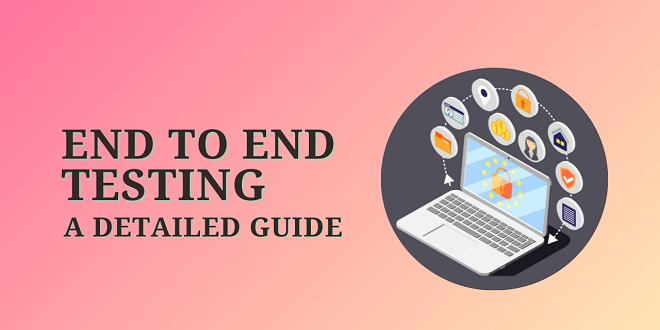The significance of E2E (end-to-end) tests as a part of the SDLC (software development lifecycle) can’t be overemphasized. It is the determining factor of Software QA (Quality Assurance). E2E tests create confidence in an app’s build by ensuring that each code line, all traits of the website, and every flow function as expected. The purpose of the E2E automation testing is to test the entire software for data integrity, dependencies, and communication with other interfaces, systems, and databases to exercise full production-like scenarios.
Along with the software application system, it also validates data/ batch processing from other downstream/ upstream systems hence, the term “End-to-End”. E2E Testing is also known as Chain Testing E2E Testing is generally executed after System and Functional Testing. It utilizes real production like data and test environment to replicate real settings.
What is the Importance of End-to-End Testing?
As most non-trivial apps are integrated with multiple workflows, systems are tremendously complicated. In such circumstances, E2E Testing determines how the app under testing behaves when integrated with all the exterior dependencies and examines bugs at each interface.
The multiple system components where E2E functions are,
- Backend
The crucial functions of any app are reliant on the backend structure. End to End Testing is merely one that estimates the layers and databases involved in the application backend.
- Multiple-Tier System
As we all know, countless apps function through multi-systems & subsystems, which forms a complex workflow and enhances the chances of bugs. End to End Testing determines the threat of errors in this format as it scrutinizes each layer involved in an app’s systems and subsystems.
- Distributed Environment
Apps that have various elements or the ones that are based on cloud environments and Service Oriented Architecture (SOA) are said to have distributed environments. Such apps need to opt for E2E Tests for the operation to succeed.
- Constant User Experience
End to End Testing counts testing an app from the start to the finish; thus, it proffers Cross Browser Compatibility. It also includes a satisfactory user experience across multiple devices, platforms, and environs.
E2E Test Procedure: Phases for End-to-End Testing
The steps below are required to start and finish any End to End Testing.
E2E Test comprises testing suites with multiple-test cases that follow the course of the software system & its subsystems and determines breaks in the flow that cause bugs. There are four distinct phases to E2E Test:
Step 1- The Test Planning Phase
The QA testing team plans as well as designs the software tests project in this phase. They look at what will influence user functions & how they will determine the testing progress. This phase also shapes part of the enterprise resource plan. The software testing team has to allocate resources and people to the project and make sure that all external dependencies are met.
Step 2- Test Design & Test Case Research Phase
QA teams look at the app from the user’s opinion and write test cases based on necessary functionality. The function of the user is determined by precise conditions, counting timing, data conditions, and sequence. Writing tests is as significant as test implementation. Software testing teams have to plan all test cases with real-time user scenarios in mind. Each test case has to serve as an element of the overall testing procedure with the definite objective to ensure software quality.
Step 3- Test Case Execution
Once the testing team has generated the test suites with better test cases that make certain proper test coverage, it’s time for the testing procedure to start. QA engineers run all separate test cases on multiple devices, counting mobile devices and varied OSs, and in variable conditions. End-to-end tests should cover all facets of the software system, comprising interconnected subsystems.
As QA’s run every test case, some might fail. When a test fails, the software tester debugs the code that broke or reports on how the functionality prerequisite of the software system hasn’t been met. Once modifications are made, or the code is set, the QA team re-runs the testing. Testing teams repeat this procedure until every test passes.
Step 4- Test Results Scrutiny
It is crucial to look at the outcomes of each test case to find out major risk factors and flaws in the software. Section of the test results analysis is reporting on the open & closed bugs/ errors status.
Key Metrics to Measure E2E Testing
Consider the following significant factors for tracking the progress of E2E Testing:
- Test Case preparation: Are the correct test cases being shaped to test every software feature? The graph reveals this must show the rate at which present vs. planned test cases are being formed.
- Weekly test: The percentage base report of test completion every single week is crucial. The vital parameters here are presently executed, not executed, as well as failed test cases.
- Details of the Defect: The percentage of defects detected, opened or closed, every week is crucial. Distributing errors (for resolution) based on priority aids QA managers and testers keep track of errors and supervise their resolution.
- Test environment accessibility: This compares the quantity of time planned for testing every day vs the time truly spent.
What are the Challenges Faced During End-to-End Testing?
Even though identifying glitches/ bugs in a complicated workflow is considered to be a great challenge in the E2E tests, apart from that there are other hitches as well. Let us take a glance.
- Structure a Workflow –The test cases in End to End Testing should be executed in sequence. In a dispersed workflow, it is hard to deal with a workflow where 1000 cases can be executed in chronological order.
- Access Problem –Customized apps can be tested easily and accurately in a virtual development environment. The actual challenge comes when you have to test an offline app in a customer or production environment. There is partial accessibility to test environments and you need to install local agents & sign in to virtual machines. And you have to discover a way to keep the machine at the time of the testing and avoid unforeseen situations such as system updates from interrupting the implementation of test cases.
E2E Testing Vs Functional Testing
| E2E Testing | Functional Testing |
| In the E2E test, we test multi apps, sub-systems, as well as user groups. | In the Functional tests, the test scope is restricted to a solo functionality. |
| It makes certain the whole system continues to function accurately after making alterations. | It makes certain that the software functionality or traits meet the acceptance criterion. |
| Here we test in a mode multi-user access to various parts of the system. | Here we test in a mode a single user accesses the application. |
| Here we validate every single step of the process. | Here we validate the output as well as the input of the system. |
What are the Benefits of End-to-End Testing?
- Ensure the Correctness of the App
Multi-layer testing eradicates bugs at each level in an app. The Testing is executed through the,
- Level 1- Data Layer
- Level 2- Business Layer
- Level 3- Integration Layer
- Level 4- Presentation Layer.
When an app is assessed and assessed through such layers, then there is a minimal possibility of product failure or app crash. Thus, it makes certain the optimal health of the software product.
- Minimizes Threats in the Future
The rigorous test techniques ensure the correctness of the app, which is a major factor contributing to no or lesser risk. After going through E2E Testing, the app faces very negligible or lesser chances of failure.
- Reduces Repetition Tests
Any app coming out of E2E Testing doesn’t necessitate repetitive Tests or going back to production. This technique itself is a full-proof process that ensures the Test is executed from start to the end.
- Cost-Effective and Time-Saving
All the above parameters have clarified already that this type of testing saves a lot of time as it doesn’t necessitate any repetitive efforts and is a cost-effective process.
- Expands Test Coverage
The E2E testing procedure incorporates all the diverse subsystems integrated with your app. If a sub-system fails, it can lead to adverse effects throughout the complete system. Therefore, End to End testing makes certain the system and its dependencies work correctly collectively.
- Increased Product Quality
Bugs are the biggest issues in any software product. The E2E method lessens the bugs/ flaws to zero, making the product superior to other tested products. Thus, increases the chances of product quality.
- Boosts Productivity
When the quality and time of a product are enhanced, it straight results in an increase in productivity as it can make sure that top products can be tested and released in the shortest period. At the same time, as the hard work of QA testers isn’t wasted, their zeal is better to reproduce higher quality products.
It is a boon for a QA tester to have a test method that can execute significant work in a very lesser time whilst managing superior quality. In addition, the customers are tremendously happy after the delivery of End o End tested products that are bug-free and error-free.
Tools Used for End To End Testing
LambdaTest
LambdaTest is an end-to-end testing platform that supports Selenium, Cypress testing, Playwright, Puppeteer, and many other testing frameworks. LambdaTest allows you to test across 3000+ browsers and operating systems simultaneously. There are many features that developers need to scale end-to-end tests, such as dashboards for monitoring flaky tests and parallel tests. With their new HyperExecute offering, they are taking test execution speed to the next level.
Puppeteer
Puppeteer is an open-source framework that lets QA testers run headless browser tests of Chrome. Puppeteer tests will enable faster and simpler E2E automated testing of pages and apps. It is a browser-automated tool built on Chromium’s DevTools Protocol, an effective protocol to communicate with web browsers from user scripts. It allows you to run headless Google Chrome in Node.js to run a majority of jobs performed by a software developer when debugging, like managing responses and requests, network traffic, locating elements, and so on.
It can assist you to automate your E2E test. With Puppeteer, it is as simple as writing some lines of code. No extraordinary configuration is required to get started. When downloading Puppeteer, it installs its Chrome version. However, if you wish to use a browser you have installed, you can install the package puppeteer-core.
Playwright
The Playwright is a new and robust tool that aids you to build modern web apps and offers you E2E testing and cross-browser test capacities. Even though Playwright is fresh to the market, it already has numerous traits that make it a tough competitor. Folks who are willing to migrate from Selenium to Playwright can perform so rapidly since Playwright supports Java, Python, and C#. Software Programmers are not restricted by the language they use; its first release was in Jan’ 2020 and its popularity have full-grown steadily since then.
The procedure of writing, automating, as well as managing E2E testing is tiresome and time-consuming. QA engineers have found that having to write End to End testing isn’t fun at all. The flakiness of the testing made them complex to manage.
It takes care of auto-waiting for components to be all set for execution, such as clicks & page navigation. It gives options to capture screenshots while an end to end testing is running. Options count as taking a screenshot of the whole page or a particular component on the web page. Besides saving the screenshot, you can find a buffer with the image and post-procedure it. If an End to End testing fails, the page screenshot will be useful to detect what went wrong & fixing it.
The Playwright is a free library to aid you with E2E testing for your app. Utilizing the codegen trait and taking benefit of its built-in mocks and assertions, you can get commenced with Playwright’s library in just a few hrs.
There are a few other testing frameworks that you can leverage for End to End as well like:
- WebdriverIO
- TestCafe
- Mocha
- Jest
What Does The Future Have in Store?
With the advancement of AI, ML, IoT, and the introduction of modern apps, we are seeing highly interconnected apps with each device in our surrounding environment. Their workflow is a bit complex but can be advantageous. Scenarios have often come up when an organizational app is deployed at a place outside the enterprise and it fails, affecting business procedures. Such circumstances can be avoided if E2E testing is performed successfully. It makes certain that the app performs correctly at each layer, particularly when it is integrated with outer systems.
With IT growing more, the QA world has already become an obligatory part of any software development method. If the accurate solution and best practices are further added, the effort spent on E2E tests can be a lot more valuable. Moreover, with software systems getting more complex gradually and as said before, the Internet of Things becoming the next popular trend in the QA industry, the future holds many in store for tests experts/ specialists specializing in E2E testing.
Conclusion
In Software Engineering, E2E Testing (End to End Testing) is the procedure of evaluating a software system along with its sub-systems. The major challenge in this test is to have adequate knowledge of the entire system and an interconnected sub-system.
The E2E test is crucial to assess how a user will communicate with your programme. Estimating the user experience from start to end provides extra assurance concerning the app’s quality than merely testing if a model appears or a button functions. End-to-end testing execution methods such as vertical testing, horizontal testing, and the distinction between automatic and manual tests were all covered.
 Tech Readers
Tech Readers




